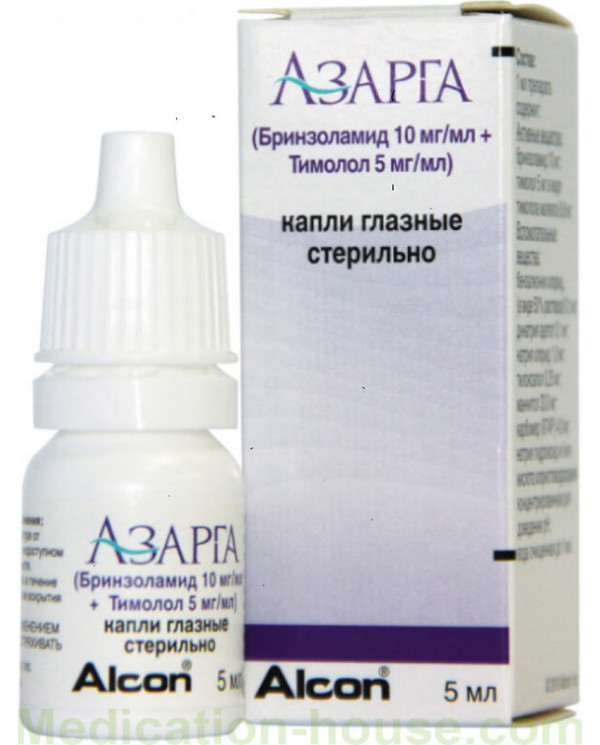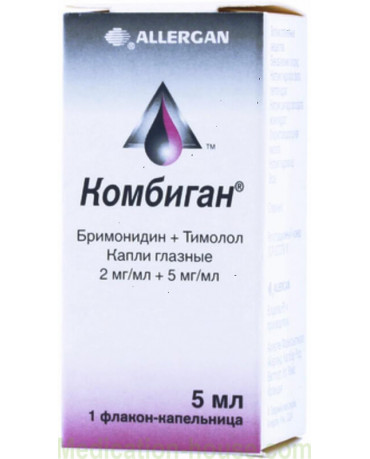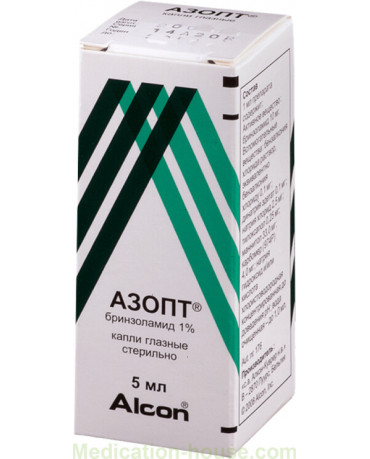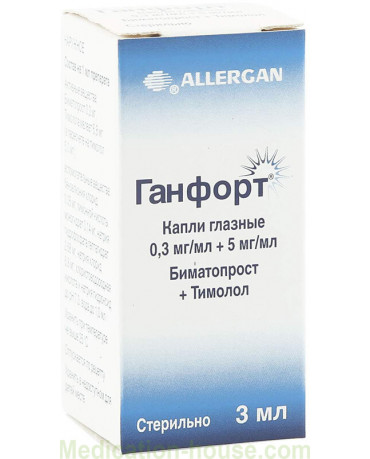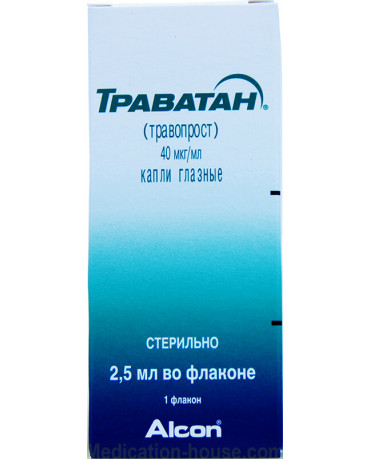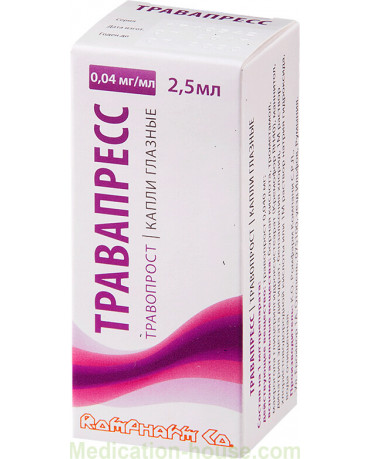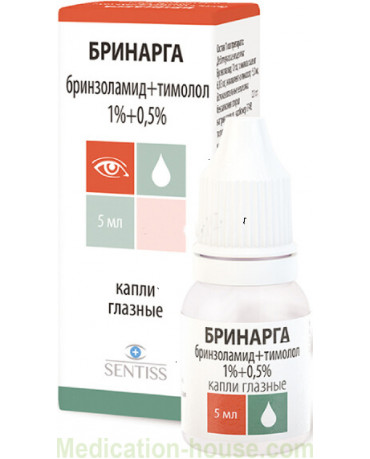Instruction for Azarga
You can buy Azarga here
Composition and form of release
Azarga eye drops are a suspension of a homogeneous texture that has a light yellow or orange color. The drug contains two active ingredients - timolol maleate and brinzolamide. Auxiliary components:
benzalkonium chloride;
purified water;
disodium edetate;
tyloxapol;
sodium chloride;
mannitol;
sodium hydroxide and / or concentrated hydrochloric acid;
carbomer.
Drops are produced in dropper bottles in a volume of 5 ml. In a cardboard box, 1 bottle and instructions.
Pharmachologic effect
Azarga is a combined antiglaucoma remedy that includes the effect of two components. Their action is aimed at reducing intraocular pressure, which is achieved by reducing the production of fluid inside the eye, only in different ways. Brinzolamide and timolol enhance each other's action and, in general, provide the drug with a pronounced anti-glaucoma effect.
Brinzolamide is an inhibitor of carbonic anhydrase 2. Due to its inhibition, the amount of intraocular fluid decreases. The action is due to a decrease in the synthesis of bicarbonate ions, the movement of sodium and liquid ions. Timolol - refers to non-selective beta-adrenergic blockers without sympathomimetic action. The substance does not have a membrane stabilizing effect and a direct depressive effect on myocardial cells. Reduces the amount of fluid in the eye and accelerates its outflow.
Pharmacodynamics
When instilled into the eyes, both active components penetrate into the general blood stream. About 60% of brinzolamide form complexes with plasma proteins and accumulate in erythrocytes, as they selectively bind to carbonic anhydrase. Due to the fact that this substance and its metabolites have an affinity for erythrocyte cells, their level in blood plasma is extremely low.
About 35% of brinzolamide is excreted by the kidneys in the urine as metabolites, about 30% in the feces. Timolol and its decay products are also excreted by the kidneys in the urine. In unchanged form, about 25% is released, the rest is metabolites.
Indications and contraindications
Ophthalmic drops are prescribed to reduce the increased pressure inside the eye with intraocular hypertension, open-angle glaucoma. Contraindications:
AV blockade 2 - 3 degrees;
CCSU (sick sinus syndrome);
sinus bradycardia;
pregnancy;
sinoatrial blockade;
severe allergic rhinitis;
bronchial asthma;
chronic obstructive pulmonary disease;
severe renal failure;
breast-feeding;
cardiogenic shock;
persons under the age of 18;
intolerance to the components of the drug, as well as hypersensitivity to beta-blockers, sulfonamides;
hyperchloremic acidosis;
severe heart failure.
Drops are used with caution in liver failure, especially severe course.
Instructions for use
Shake the vial with the suspension before each instillation. In order not to contaminate the bottle and its contents, it is not recommended to touch the dropper with your hands, and also to lean it against your eyelashes and skin. The drug is instilled in 1 drop into the conjunctival sac - under the lower eyelid 2 times a day. If a person missed the instillation, then the next time he also introduces 1 drop without adding the missed one. It is prohibited to exceed the amount of the drug.
Since the agent enters the systemic circulation. To reduce its level in plasma, immediately after instillation, you need to lightly press for 1 - 2 minutes with one finger on the area of the lacrimal sac, which is located at the inner corner of the eye. This action will reduce the likelihood of developing side effects.
If a person used any antiglaucoma remedy, and then Azarga drops were prescribed, then they can be used only 24 hours after the other medication was canceled. When wearing lenses, they must be removed before instillation and put on again after 15 to 25 minutes.
Side effects
In the course of research, a number of side effects have been identified. The most common:
blurred vision;
irritation of the mucous membranes of the eye;
constriction of the pupil;
redness of the conjunctiva;
foreign body sensation, itching and pain in the eyes.
In rare cases, there is:
corneal erosion;
reduced formation of tear fluid;
allergic conjunctivitis;
swelling of the eyes;
veil on the cornea;
lacrimation.
Other side effects that are not related to the organs of vision are: insomnia or drowsiness, decreased blood pressure, exacerbation of chronic lung diseases, apathy, disruption of the central nervous system, depression, decreased libido. These side effects are associated with the penetration of active components into the general blood flow.
Overdose
When applied topically, overdose is unlikely, possibly the appearance or intensification of side effects. If a person has dripped more drops, it is necessary to rinse the eyes with water. When the drug enters the gastrointestinal tract, that is, when it is drunk, the symptoms of an overdose may appear as:
spasm of the bronchi;
lowering blood pressure;
bradycardia;
heart failure;
disturbances in the balance of electrolytes in the blood;
disorders of the central nervous system.
Overdose treatment is symptomatic, which is aimed at relieving symptoms from certain organs and systems.
Drug interactions
Azarga drops are not recommended for use with the following drugs:
oral carbonic anhydrase inhibitors;
calcium channel blockers;
systemic beta-blockers;
adrenalin;
cardiac glycosides;
parasympathomimetics.
If these funds are combined with drops, then their therapeutic effect may increase or side effects may appear, both from the side of Azarga's drops and from these funds.
Special instructions
When treating with drops, the concentration of attention may decrease in the elderly, visual acuity in middle-aged people, which must be taken into account when driving. Also, after using the drops, side effects in the form of blurred vision are possible, therefore, it is necessary to start work requiring clear vision no earlier than after 30 minutes.
Before instillation, lenses from the eyes must be removed and put on after 15 to 20 minutes. If a person simultaneously uses 2 or more ophthalmic agents, then the interval between them should be about 10 minutes. This is necessary so that subsequent drops do not wash away the previous ones.
When instilling, do not touch the dropper with your hands or touch it to the eyelids, skin. Drops should not be used by pregnant and lactating women. When breastfeeding, they can be used only if the child is transferred to artificial feeding for the period of treatment. Feeding can be resumed only after drug withdrawal.
If a person has cardiovascular diseases, such as heart failure, coronary heart disease, angina pectoris, low blood pressure, then the risk of their complications should be taken into account when using Azarga drops. The tool is used with caution in case of impaired peripheral circulation, lowering blood sugar levels.
In myasthenia gravis, the drug can worsen muscle weakness. Azarga can mask the signs of hyperthyroidism. If a person has had severe allergic reactions in the past, including anaphylactic shock, then during treatment they may react more strongly to allergens that have caused these reactions in the past.
Storage conditions and shelf life
The drug should be kept in a place protected from children and direct sunlight, at a temperature not exceeding 30 ° C. Shelf life - 2 years, from the date of release of the drug, which is indicated on the package. Once opened, the drops can be used for up to four weeks. After this period, the drug must be disposed of.
Reviews
Marina, 32 years old
My aunt has been treating glaucoma for 3 years. Before the drops of Azarga, she was prescribed some other drops, but from them she had side effects in the form of severe pain and itching in the eye. After using Azarga, she did not experience any unpleasant reactions. The aunt had high intraocular pressure, and after using the drug it returned to normal, and glaucoma does not progress.
Albina, 41 years old
I have already had 2 eye surgeries for glaucoma. After each operation, I was prescribed anti-inflammatory drops so that there were no inflammatory complications and pain. And after them drops of Azarga. High pressure in the eye drops quickly, and the swelling after the operation has disappeared. I did not notice any side effects.
Terms of sell
You can buy Azarga without a prescription.

